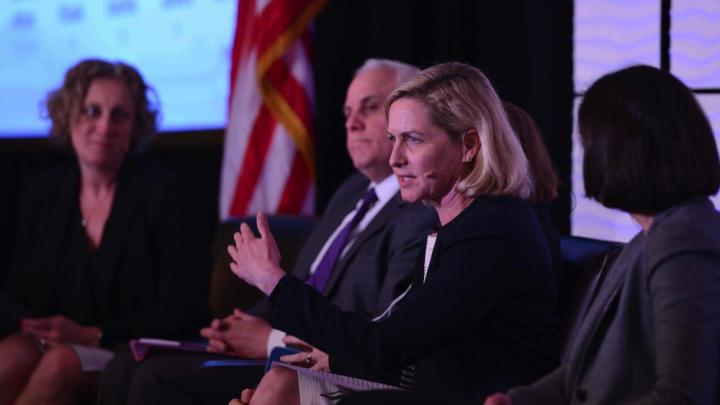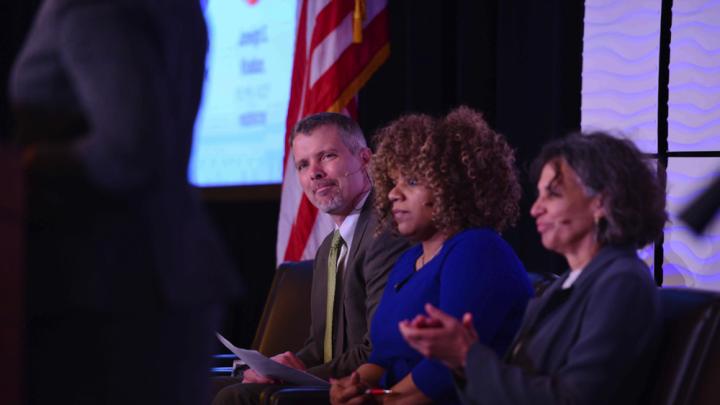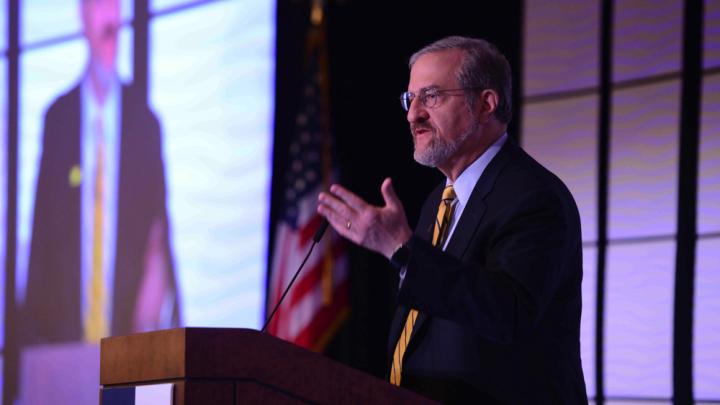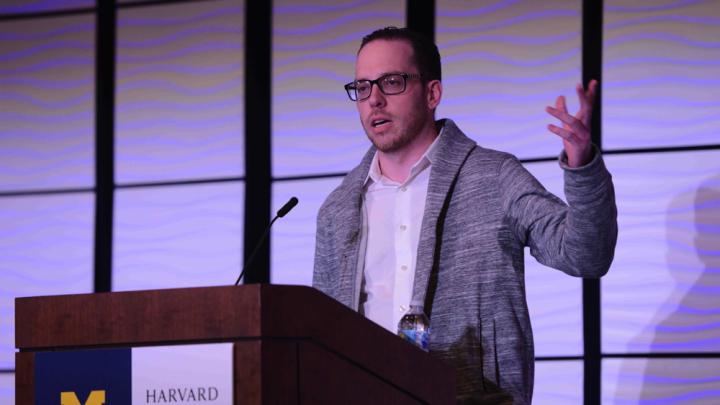Last fall, President Lawrence S. Bacow and University of Michigan president Mark S. Schlissel announced a research and public-policy partnership between the two institutions focusing on the issues of poverty and the opioids crisis. On May 10, the first manifestation of that partnership arrived as researchers, physicians, and experts from Harvard and UM convened in Ypsilanti for a summit on “Opioids: Policy to Practice.”
In his introductory remarks at the event, Schlissel said, “As our world becomes smaller, the inverse is true of our problems.…They become bigger and more complex, and will not be solved in isolation.” Some 100 Michigan faculty members are studying many aspects of the opioid epidemic, he reported, and Opioid Solutions, a campus initiative in Ann Arbor, serves as a central hub for the university’s work in that area, combining research, policy, community engagement, and an injury-prevention center.
Harvard’s effort to combat the crisis—which is now the nation’s largest public-health epidemic, claiming some 130 American deaths from overdose every day—is newer and still developing. (“The Opioids Emergency,” in the March-April Harvard Magazine, covers the work of several University medical researchers active in the field.) It is led by Mary Bassett, director of the François-Xavier Bagnoud Center for Health and Human Rights, based at the Harvard T.H. Chan School of Public Health (SPH). Bassett was formerly commissioner of New York City’s department of health and mental hygiene, and before that, she spent two decades working in and teaching about public health in Zimbabwe. “The fact is, the public-health approach to the opioid is not rocket science,” Bassett said last Friday. “It may be hard to do, but it’s not rocket science.” Her approach, which she outlined briefly, includes the need to “keep people alive” through harm-reduction measures like syringe-exchange programs and widespread access to naloxone; reducing the harm and dangers of prescription painkillers; and “effective treatment everywhere.” Only 20 percent of people with substance use disorder are in treatment, she said, “and not all of them are even in effective treatment.…No one should have their treatment interrupted by incarceration.”
Bassett co-chaired the daylong summit, alongside Chad Brummett, director of pain research at UM. The conference drew some 400 participants—the room stayed full throughout the day—and included speakers from the medical and health-policy world as well as members of law enforcement, the military, and the insurance industry. Several themes emerged repeatedly, as panelists circled the larger topic:
- Opioids do not treat pain as effectively as has been generally believed, especially chronic, non-cancer pain. “These are really dangerous drugs, and they don’t work that well” for chronic pain, said Daniel Clauw, director of UM’s Chronic Pain and Fatigue Research Center, echoing other speakers. “Put them back where they belong: a last-line therapy in people that have [tried] everything else.”
- Research increasingly shows that other analgesics and non-pharmacological pain-relief methods, such as chiropractic manipulation, acupuncture, physical therapy, and yoga, can be as effective, sometimes even more effective than opioids, and it is imperative to establish reimbursement models in Medicare and private insurance for these other treatments. Such reimbursements are currently lacking.
- Timely, robust, actionable data on opioids are needed to help researchers and policy-makers effectively and nimbly address the problem. “We are often making decisions based on old data,” said Thomas Simmer, chief medical officer for Blue Cross and Blue Shield of Michigan. Bassett noted the Massachusetts initiative, Chapter 55, signed into law in 2015, which allowed the state’s department of public health to link nearly 20 databases relevant to the opioid crisis. “They’ve been able to put a number on the risk of fatal overdose for people after they’ve been incarcerated: 130-fold higher,” Bassett reported. “And for homeless individuals: 30-fold higher. They’ve even been able to put together the people who got prescribed opioids for three months or more and follow them over time through these databases, to figure out what the length of time was to an overdose: 36 months.”
- Stigma remains a barrier to solving the crisis. During one panel discussion, an audience member asked about research on how to transfer substance-abuse patients from medication-assisted treatment, which uses therapies like buprenorphine, to abstinence-based recovery. Rebecca Cunningham, who heads Michigan’s Opioids Solutions program, answered that although more research is needed on medication-assisted treatments, there was stigma inherent in the question. “There’s a lot of chronic diseases where we’re perfectly okay with people being on therapy if that’s what they need to get through the rest of their life successfully as happy productive members,” she said. “I don’t have stigma for people who are on thyroid or insulin medication every day for the rest of their lives. That’s what they need for their primary disease.”
- Deaths from cocaine and psychostimulants like methamphetamines are trending worryingly upward, even as the numbers of deaths attributed to opioids and heroin—still vastly higher—are beginning to flatten out or fall slightly in some parts of the country. In her remarks, Rear Admiral Sylvia Trent-Adams, principal assistant secretary for health in the U.S. Department of Health and Human Services, warned that these drugs could become a “fourth wave” of the opioid crisis. “This keeps me up at night,” she said. Craig Summers, a former narcotics enforcement officer who now heads a federal program aimed at bringing together local, state, and federal law-enforcement efforts, reported that seizures of methamphetamines and cocaine in Michigan had doubled last year.
“As If They Were the Good Prescriber”
Several speakers presented preliminary results of unfolding research at the summit. Michael Barnett, M.D. ’11, S.M. ’16, a primary-care physician at Brigham and Women’s Hospital and assistant professor of health policy and management at SPH, has been studying the effectiveness of state and local prescribing laws that have flurried into existence. Recently, he examined the outcomes for chronic-pain patients whose opioid therapy was discontinued; there have been disturbing reports chronicling rising suicides and desperation among such patients who see their prescriptions cut as laws change and doctors become wary of prescribing opioids.
One finding Barnett and his team uncovered: most long-term opioid patients are tapered off their prescriptions too quickly and too drastically. Using Medicare data of patients on 12 months or more of opioids for chronic pain, “We were stunned to find that only a tiny minority of patients have their chronic opioid therapy stopped within [Centers for Disease Control] guidelines,” he said. “And in fact, if anything, the majority of patients have no taper at all.…This is of course quite contrary to expert consensus and could be the source of significant suffering.” (A few minutes later, another panelist, UM psychiatry professor Amy Bohnert, who was part of the team that wrote the 2016 CDC guidelines about opioid prescribing and how to taper patients off the medicines, recalled talking to some doctors who were proud of having abruptly stopped their patients’ therapy, “as if they were the good prescriber, and not even realizing that’s not good quality care, and that it’s putting their patients in harm.”)
In a related study, Barnett tried to determine what happens next for those patients by looking at the behavior of their family members. Examining a decade’s worth of insurance claims, Barnett found that in the days around the time opioids were discontinued for patients in the top 10 percent of usage, there was an enormous spike in family members filling their very first opioid prescriptions. “To us, this is evidence that the health system could be profoundly failing some chronic opioid users, to the extent that a family member might actually have to step in and help their loved ones” by obtaining their own prescription to give to the patient who can no longer get one. “I think this is not an implausible explanation for what we’re seeing.”
In yet another study, Barnett also found that despite new, stronger prescribing laws that have helped reduce the number of opioid prescriptions by 50 percent from their peak in 2011 and 2012, the total number of people on opioid therapy at any point has not fallen, and in fact may be increasing a little. “For us, what this means is that despite all the changes in the health-care system, chronic opioid use is just as common as ever, and the challenges of how to design policy that would compassionately account for these [chronic-use, opioid-dependent] patients—that problem is just as prevalent as ever.”
Addressing Addiction Treatment, Not Prescribing
During a question-and-answer session, Brummett, the panel’s moderator, asked what policies are still needed to combat the crisis. Barnett’s answer: policies that address addiction treatment, rather than prescribing. “Physicians are decreasing prescribing,” he said. “They have gotten the message….Meanwhile, at the state legislative level, [legislation to further restrict prescribing] distracts us from the real challenge, which is in addiction treatment, and the huge changes we can make to our mental-health treatment structure that have not been as much a part of the policy conversation as it should be.”
Meredith Rosenthal, Gray professor of health economics and policy at SPH—and one of many panelists serving as an expert plaintiffs’ witness in litigation against pharmaceutical companies over their role in generating the crisis—spoke about research, hers and others’, into pharmaceutical marketing, which is aimed at both consumers and physicians and costs some $20 billion per year. The regulatory framework for this marketing she described as “a very light-touch set of rules and enforcement mechanisms”—in other words, she said, “a fox in the henhouse.” Studies show that despite the fact that doctors deny relying on commercial sources of information, their beliefs about the risks and benefits of pharmaceuticals hew much closer to those commercial sources than to published scientific results.
It’s been proven, Rosenthal said, that physicians were misled by marketing of opioids. “And this should not be surprising,” she added. “Marketing is effective….I don’t know why we should expect physicians to be any different in terms of the effect of marketing.” She worries much more about marketing pitched to professionals—individual doctors and medical societies—than to consumers, in part because the consumer-targeting is out in the open; marketing to doctors happens behind closed doors. “I do wonder if it’s time to think about changing the way we regulate pharmaceutical marketing, particularly when it comes to face-to-face interactions between the industry and prescribers.”
“Compassion and Care”
Bassett spoke toward the end of the summit, and shared a panel with UM public-policy researcher H. Luke Shaefer, who directs Poverty Solutions, a 2016 UM initiative with which Harvard’s Equality of Opportunity Project has partnered, related to the joint opioids work. Shaefer had spoken earlier about the social determinants of addiction—poverty, trauma, “toxic stress”—and noted how the money spent on therapies such as opioid prescriptions far outweighed the money spent on other kinds of aid. The coauthor of $2 A Day: Living on Almost Nothing in America, he advocated more income support as well as housing resources, child care, and job support. “I would encourage us to ask the question of whether the opioid crisis is only the most deadly example of a broader set of phenomena that we have to address.”
Later, he added: “I think the only way we can turn the tide on social determinants” of addiction, “is if people in this room and a lot of rooms like it start to recognize these things as central to the work that we do.”
Bassett picked up that idea in her own remarks, saying that health-care providers and policymakers “need to start using some of this same language” from social-welfare research. “We need to take a step back from talking about what and how we should be doing, to ask ourselves: Why are we here? How did we come to be in a place where it’s still so controversial to talk about keeping people alive, broadly known as harm-reduction strategies? Why do we only have three drugs to treat opioid dependence? Imagine if we only had three drugs for hypertension, heart disease, diabetes. And why is there so much stigma and shame among people who use drugs?”
Then she spoke to the issue of race, an undercurrent of the entire day. “The previous epidemic, the heroin epidemic, largely affected people of color—black and brown people,” she said. “Black and brown people got the War on Drugs. It was not greeted with the compassion, sympathy, or empathy that we’re seeing, correctly, now. It was not greeted with treatment. It was greeted with punishment, handcuffs—not help.”
She returned to the information yielded by Massachusetts’s Chapter 55, which united opioid-related databases, revealing a slight decrease in opioid-related deaths in the state during the past two years. “When Massachusetts looks more closely at its data, you can see that the downtick…was not a downtick for everyone.” Deaths among African Americans are continuing to rise, though the opioid mortality rate is still lower than for whites. “Particularly hard hit are black men…we haven’t bent the curve in the black population. And I’m terribly afraid that as the demographics of this epidemic shift”—from an crisis dominated by whites to one that also increasingly affects nonwhites—that “it’s the people with the resources and capacity who protect themselves the fastest. We need to keep our eye on maintaining compassion and care. We have already paid too high a price—all of us, regardless of how we identify—for a response that was based on punishment.”
A second opioids summit between Harvard and Michigan, part of the institutions’ several evolving partnerships, will take place in Boston this coming October. It will focus on access to treatment and the role of stigma in the crisis.












